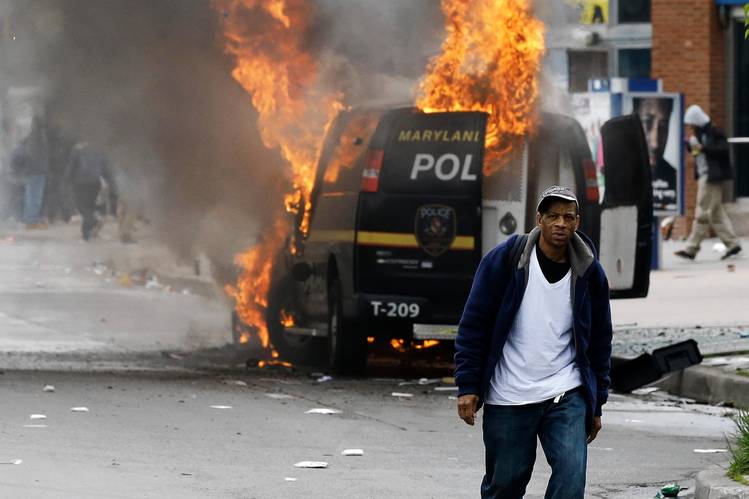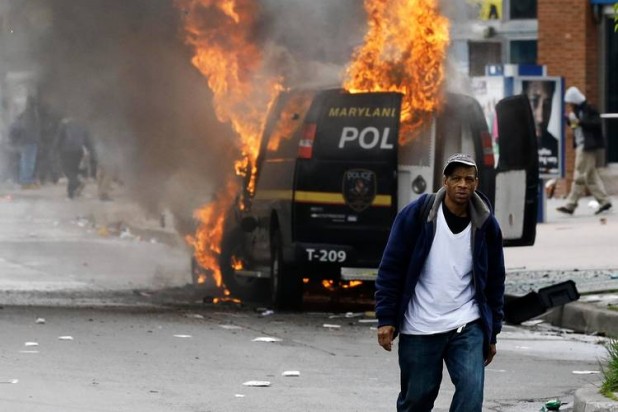Stuff Black People Don’t Like
December 22, 2015
This is the world white people long ago envisioned coming to fruition if their rule was replaced with something else.
Something sinister. [Heroin creates crowded illicit economy in Baltimore, Baltimore Sun, 12-19-15]:
For Anthony Miles, Feb. 15, 2013, was a busy day of juggling calls, setting up meetings and touting a high-quality shipment he was expecting soon. Still, he found time to put air in the tires of his Mercedes and to note how well the day was going.
Raising a large stack of bills in both hands, he bragged to a companion: I just made $20,000 in one hour.
Just three days later, Miles was less euphoric. He grumbled he was making “chump change” while an associate was clearing $150,000 a day “with his eyes closed.”
Workplace jealousies aside, Miles and his colleagues were making eye-popping sums in their chosen profession of heroin dealing — however fleetingly. Using evidence, including audio-video recordings of Miles’ conversations, federal prosecutors would indict and ultimately win convictions against him and about a dozen other members of the drug-trafficking organization, seizing some of the spoils, including more than $140,000 in cash, luxury cars, a 33-foot Doral boat and a Cartier watch encrusted with more than 20 carats of diamonds.
In Baltimore, where heroin has a long-entrenched history, the drug has created a thriving subeconomy, providing funds for dealers who buy mansions in the suburbs or simply help family members with rent and grocery money.
The size of this subeconomy is not easily calculated, though nationally, experts estimate heroin users spend about $27 billion a year on the drug.
In Baltimore, where there are an estimated 19,000 heroin users, including roughly 9,500 chronic users, annual spending on the drug is estimated to be at least $165 million. Such estimates — derived from Mayor Stephanie Rawlings-Blake’s 2015 heroin task force and a 2014 study by the RAND Corp. for the White House — are imprecise given the nature of the drug market and the difficulty of surveying heavy heroin users. But experts say the actual valuation is likely much higher because of money spent by occasional users.
Sometimes indications emerge of the scale of the trade here: When the brothers of one local kingpin, Steven Blackwell, were kidnapped, he came up with $500,000 for ransom. When investigators searched a stash house and home of another dealer, Sean Wilson, who was ultimately convicted, they found $464,283 and $74,980, respectively. And when the home of a Miles associate, Antoine Wiggins, was searched, a bedroom dresser drawer yielded more than $81,000.
But as in the legitimate economy, experts say, such wealth is largely limited to those at the top levels of the heroin trade. At the bottom, the so-called “corner boys” who sell on the street can be making as little as minimum wage, according to economists who have studied the market and those who have plied the trade themselves.
“Nobody’s getting [rich] if they’re on the corner,” said James Wooding, 51, a former heroin dealer and addict who works as a janitor at Tuerk House, the treatment program in West Baltimore that helped him get clean two years ago.
“They’re just making sneaker money, or for some girl, diapers for the baby.”
And yet there seems to be an unending supply of mostly young men willing to do this entry-level work — however low-paying and, of course, illegal and dangerous.Among them was Freddie Gray, the 25-year-old whose death in police custody in April triggered protests and rioting in Baltimore and led to criminal charges against six police officers. The first trial, of Officer William G. Porter, resulted in a mistrial last week when jurors could not reach a unanimous decision on any of the four charges he faced.
Gray had been arrested more than 15 times on drug and other charges, and served more than two years in jail for narcotics charges, yet he repeatedly returned to the corners. Friends and acquaintances say he was aiming to stop dealing when he was arrested in April at North Avenue and North Mount Street, an area authorities had targeted for an enhanced “narcotics initiative.”
Freddie Gray had five pending drug chargers the day he ran from police in Baltimore… he was selling drugs on the very same corner he had been arrested on Sept. 28, 2013 for the distribution of heroin (he was able to plea down to 100 community service).
In a sane world, every known heroin dealer would be publicly executed as a reminder to those would be heroin dealers what happens to those who sell poison in their community.
In our insane world, social justice warriors like David Simon (creator of The Wire) become multi-millionaires by creating heroes and a mythology out of these drug dealers, and blaming black dysfunction on structural racism and other imaginary white goblins.

